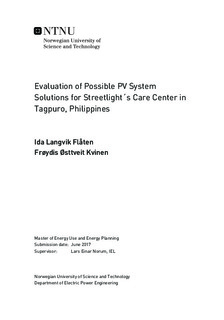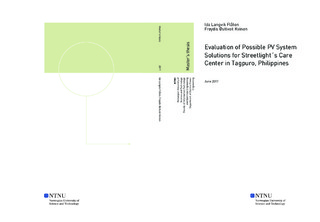| dc.description.abstract | This thesis has evaluated different photovoltaic (PV) system solutions applicable for Streetlight in Tagpuro. The evaluation has consisted of on-grid and off-grid system designs.
Streetlight operates a care center in Tacloban and Tagpuro, on the island Leyte in the Philippines. The Philippines is located at one of earth´s most exposed and vulnerable areas considering earthquakes, volcanic eruptions and typhoons. Socio-economic challenges are products of the environmental challenges in the area.
The local energy situation is characterised by frequent power outages and voltage drops - blackouts and brownouts. This is a challenge for Streetlight´s operation, and a more reliable electricity supply is desired. According to the local grid operator, the situation will improve in the future due to implementation of a new sub-station in the area. However, there is projected a power deficit in the coming years for the region.
The Philippines has the highest electricity tariff compared to their neighbouring countries and Streetlight wishes to evaluate whether it is feasible to invest in a PV system to reduce energy costs. Further Streetlight wishes to be self-sufficient with renewable energy as the energy source.
The solar potential in the Philippines is high and there are several governmental instruments providing benefits for investors in solar energy. The benefits include net-metering, feed-in tariff, tax and fiscal incentives. However, feed-in tariff is not yet implemented in Tacloban or Tagpuro.
The annual load demand of Streetlight Tagpuro was theoretically estimated to 54.94 MWh and annual critical load demand was estimated to 32.22 MWh. This is based on daily load profiles for Monday-Friday, Saturday and Sunday. The daily profiles illustrate a peak power demand during day-time 08:00-17:00 and lower power demand during the night. The power demand at night is related to outside lighting which is categorised as a critical load regarding safety concerns.
The on-grid cases evaluated PV modules located at all buildings (Office, Study Center and Orphanage), two buildings (Office and Study Center) and one building (Office), separately. The off-grid case evaluated PV modules at all buildings with different battery capacity and a maximised roof area. The on-grid an off-grid cases provides different possibilities and limitations, and the most feasible solution will depend on which factors Streetlight highlights.
A Levelized Cost of Energy (LCOE) analysis was conducted for all the cases, emphasising the sensitivity of the input parameters discount rate, battery price and net-metering rate. With a discount rate of 10 %, the PV system with modules at the Office at 7.71 PhP/kWh proved to be profitable compared to today´s situation with energy from utility at 7.93 PhP/kWh. Further, when utilising all buildings the LCOE was 8.79 PhP/kWh for the on-grid system compared to 30.32 PhP/kWh for the off-grid system. | |

